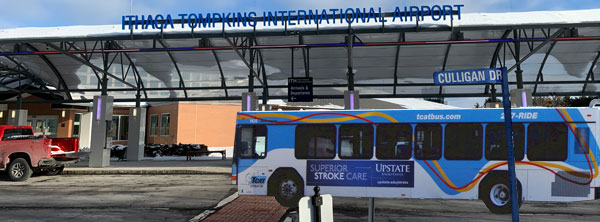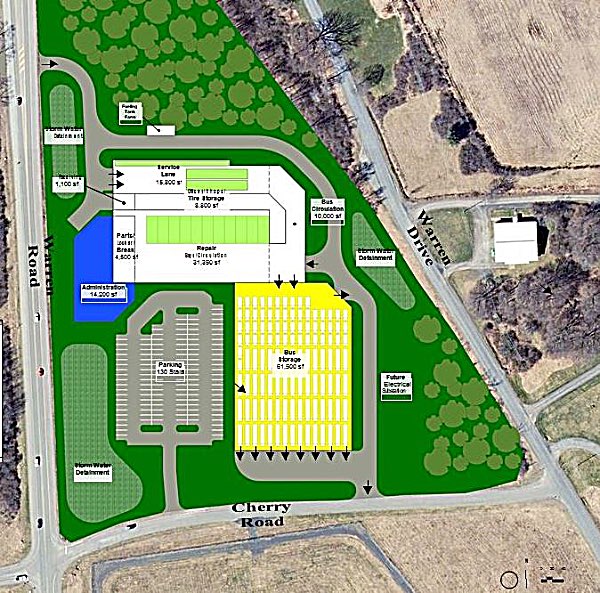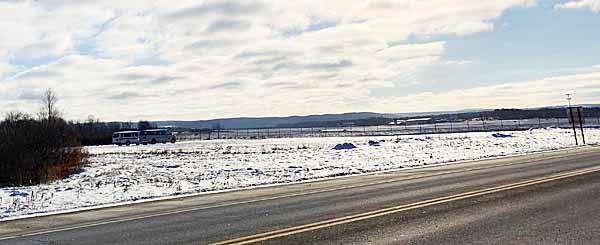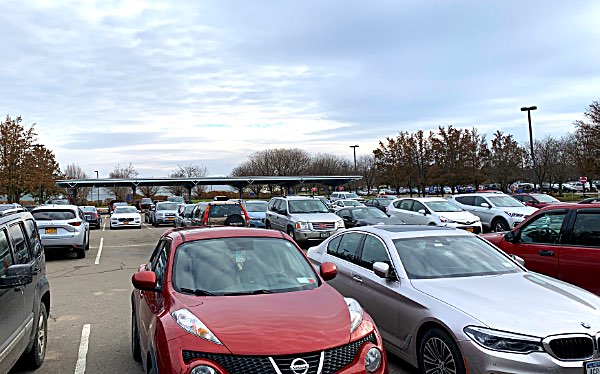- By Dan Veaner
- News
 Print
Print 
Now that the $34.8 million Ithaca-Tompkins International Airport expansion is officially finished, it's time to sit on our laurels and just enjoy it. Right?
Wrong, according to Airport Manager Mike Hall, who is already envisioning the next steps in the airport's -- and Tompkins County's -- transportation future. His vision isn't limited to airplanes. It has more in common with the 1987 movie title "Planes, Trains, and Automobiles". Because, while Hall is looking to expand airport operations, he is taking a wider view that will impact the whole county. The next big step may bring TCAT headquarters to a plot of land north of the runway.
"That's not by accident," Hall says. "We're hopeful that we're going to be able to create an integrated air ground transportation hub around the airport. Um, and uh, you know, I think it's been known for some time that not only are TCAT's facilities aging, but they're also located in prime development territory just as DOT was. So it makes sense to try to integrate transportation functions and, and that's what we're hoping we'll be able to do -- to bring them up here."
 TCAT graphic
TCAT graphicAfter considering a number of locations The TCAT Board voted to focus on relocating its 27 year-old Willow Avenue headquarters to a plot of land north of the Airport, at the corner of Warren and Cherry Roads. A tentative plan shows a 130-space parking lot, as well as a 61,000 square foot bus parking area, a 31,350 square foot repair shop, 8,8000 tire storage area, and a 14,200 square foot administrative office facility. Consultants estimated a $55 million proce tag, but board members said that there were many reasons to recommend the site, including being able to design a site from scratch to meet TCAT's needs, to take advantage of potential funding sources because of the proximity to the airport, and saving costs by sharing services.
At the December Lansing Town Board meeting Supervisor Ed LaVigne said the location would not negatively impact the tax base, because the Cornell university-owned property is not taxed now.
Last February the airport received a state grant of $1.5 million to build a shared fueling facility, probably to be located behind the Tompkins County Public Safety building, and straddling the fence so that airplanes and other airport vehicles -- including its own dire department vehicles -- as well as other county vehicles including Sheriff's Department cruisers can be fueled. Other agencies have been eager to use the shared facility, including the NYS DOT, which is building its new facility across the street from the airport. the TCAT Board said that the bus facility might also use the shared fueling facility, one of the benefits of moving to the airport location.
When the West Seneca Street bus station closed, intercity buses began using a location on Green Street to pick up and drop off passengers. That is not seen as an ideal solution, and the city government is reportedly struggling to find a permanent home for intercity bus lines. Mayor Svante Mayor Myrick has reportedly considered including an intercity bus terminal in the Seneca Street Parking Garage at some future time. But Hall has another idea.
Hall envisions a county-wide transportation hub based around the airport location. If the intercity bus station were to move near the airport as well as relocating TCAT there, air and bus travel could be linked, as well as expanding airport parking at a growing airport, where many air passengers leave their car on Cornell land to avoid parking fees.
In the past Hall has talked about moving from current east coast hubs near New York City and Philadelphia to inland hubs such as Detroit and Charlotte that are less plagued by flight-delaying weather. There may come a time when there are no commercial flights from Ithaca to to New York City, but buses that can make the run in a time frame that is not much longer than flying once you factor in parking, checking in, the security line, and then transportation into the city, If TCAT can secure Federal Transit Administration capital funding for the $55 million relocation, and an intercity bust station were also located there, Hall says all these kinds of travel could be integrated into a single convenient system.
 Land at the corner of Warren and Cherry Roads, immediately north of the airport, is a potential site for a new TCAT bus headquarters.
Land at the corner of Warren and Cherry Roads, immediately north of the airport, is a potential site for a new TCAT bus headquarters."We're trying to get an integrated County transportation system," Hall says. " One thing that's a step forward is that TCAT has chosen this site as their primary interest. And the city would have to speak about their perspective and Cornell would have to speak about their perspective. The key elements would be a parking lot, which would serve both the airport and TCAT and to have an intercity bus terminal. So you could come here, park your car, get on the bus, ride a TCAT bus up from downtown, get on the inner city bus, and then also have a modern garage for the buses."
Hall says that integrating these transportation options would also remove a lot of car traffic from the equation, especially for city dwellers who could take a local bus to the hub, then transfer to an intercity bus or plane. A shuttle or TCAT bus would loop between the new TCAT location and the air terminal, potentially making the new parking lot a park and ride location, as well as helping to relieve airport parking.
"That could be a very simple loop," Hall says. "You could have a shuttle from downtown to the airport. There's a lot of things, a lot of potential associated with that to keep cars out of the equation. And if there were a parking lot up here and a shuttle, that affects parking downtown -- which is a tight proposition. It makes a lot of sense, but there's a lot of detail to be filled in."
While reducing automobile traffic is one of the benefits of a transportation hub, other plans include the introduction of electric baggage tugs at the airport, and a long term TCAT plan to replace diesel buses with electric ones. The airlines will be providing the electric tugs, the first of which are slated to arrive in 2020. Hall says they make a lot of sense because the vehicles are never more than a few hundred feet from an electrical outlet for recharging.
But the other things will cost money, and a lot of it. In December Tompkins County Legislator (Lansing) Mike Sigler told the Lansing Town Board "That's a long road ahead." He said that before any final decisions are made many studies will be conducted, and noted, "It's just so much money. I mean, the Governor's budget right now is 6 billion in the hole. They would need a lot of state aid to get $57 million to build this facility. So I'm not overly optimistic that it's even going to happen."
 There is plenty of room in the long and short term airport parking lots for more solar-panel-covered parking shelters (in the distance in this picture) such as the one that was constructed as part of the airport expansion project. Airport Manager Mike Hall says the wiring is in place in the existing one for future automobile recharging stations, and will be included in future ones as they are funded and built.
There is plenty of room in the long and short term airport parking lots for more solar-panel-covered parking shelters (in the distance in this picture) such as the one that was constructed as part of the airport expansion project. Airport Manager Mike Hall says the wiring is in place in the existing one for future automobile recharging stations, and will be included in future ones as they are funded and built.In addition to the opening of a customs facility in the first quarter of 2020, the airport will see the relocation of its fueling facility to the new shared location. Local aviation experts have long argued that having student pilots flying so near the current fueling facility is not exactly the safest plan, even though there have been no incidents. Once the fueling facility is relocated the current location will be the site of a new flight academy, which will transform East Hill Flying Club into a regional flight training destination.
Hall says at some point in the future the control tower, which now cramps space for operations at some of the new gate areas, will be relocated near the Very High Frequency (VHF) Omni-Directional Range (VOR) beacon on the other side of the runway. As money becomes available more parking lot shelters with solar panels on top are planned for the short term and long term parking lots.
He also envisions an international trade zone, with a warehouse near the airport to support the County's growing international business activity. Considering his successes at transforming the airport, it is not difficult to imagine this idea bearing fruit. And if TCAT is half as successful as Hall in obtaining funding, a unified transportation hub in the south-east corner of Lansing could well be part of Tompkins County's future, reducing fossil fuel emissions, while increasing business growth and opportunities to the region.
v16i1



